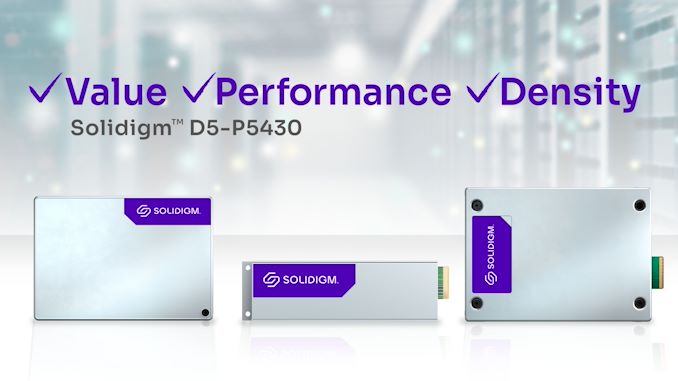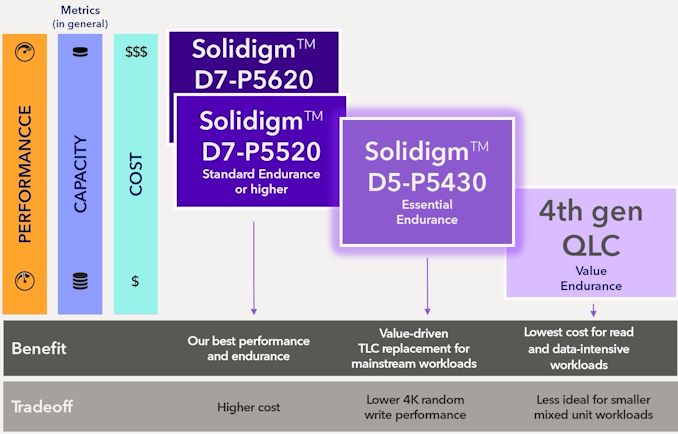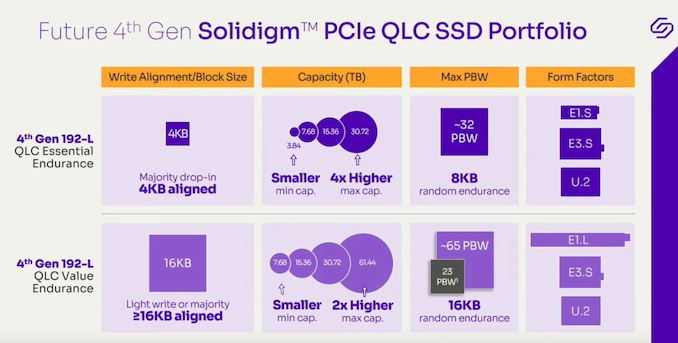Solidigm has been extremely bullish on QLC SSDs in the data center. Compared to other flash vendors, their continued use of a floating gate cell architecture (while others moved on to charge trap configurations) has served them well in bringing QLC SSDs to the enterprise market. The company realized early on that the market was hungry for a low-cost high-capacity SSD to drive per-rack capacity. In order to address this using their 144L 3D NAND generation, Solidigm created the D5-P5316. While the lineup did include a 30TB SKU for less than $100/TB, the QLC characteristics in general, and the use of a 16KB indirection unit (IU) resulted in limiting the use-cases to read-heavy and large-sized sequential / random write workloads.
Solidigm markets their data center SSDs under two families - the D7 line is meant for demanding workloads with 3D TLC flash. The D5 series, on the other hand, uses QLC flash and targets mainstream workloads and specialized non-demanding use-cases where density and cost are more important. The company further segments this family into the 'Essential Endurance' and 'Value Endurance' line. The popular D5-P5316 falls under the 'Value Endurance' line.
The D5-P5430 being introduced today is a direct TLC replacement drive in the 'Essential Endurance' line. This means that, unlike the D5-P5316's 16K IU, the D5-P5430 uses a 4KB IU. The company had provided an inkling of this drive in their Tech Field Day presentation last year.
Despite being a QLC SSD, Solidigm is promising very competitive read performance and higher endurance ratings compared to previous generation TLC drives from its competitors. In fact, Solidigm believes that the D5-P5430 can be quite competitive against TLC drives like the Micron 7450 Pro and Kioxia CD6-R.
Solidigm D5-P5430 NVMe SSD Specifications | ||
Aspect | Solidigm D5-P5430 | |
Form Factor | 2.5" 15mm U.2 / E3.S / E1.S | |
Interface, Protocol | PCIe 4.0 x4 NVMe 1.4c | |
Capacities | 3.84 TB, 7.68 TB, 15.36 TB E1.S / U.2 / E3.S | 30.72 TB U.2 / E3.S |
3D NAND Flash | Solidigm 192L 3D QLC | |
Sequential Performance (GB/s) | 128KB Reads @ QD 256 | 7.0 |
128KB Writes @ QD 256 | 3.0 | |
Random Access (IOPS) | 4KB Reads @ QD 256 | 971K |
4KB Writes @ QD 256 | 120K | |
Latency (Typical) (us) | 4KB Reads @ QD 1 | 108 |
4KB Writes @ QD 1 | 13 | |
Power Draw (Watts) | 128KB Sequential Read | ?? |
128KB Sequential Write | 25.0 | |
4KB Random Read | ?? | |
4KB Random Write | ?? | |
Idle | 5.0 | |
Endurance (DWPD) | 100% 128KB Sequential Writes | 1.83 |
100% 4KB Random Write | 0.58 | |
Warranty | 5 years |
Based on market positioning, the Micron 6500 ION launched earlier today is the main competition for the D5-P5430. The sequential writes and power consumption numbers are not particularly attractive for the Solidigm drive on a comparative basis, but the D5-P5430 does win out on the endurance aspect - 0.3 RDWPD for the 6500 ION against 0.58 RDWPD for the D5-P5430 (surprising for a QLC drive). Solidigm prefers total NAND writes limit as a better estimtate of endurance and quotes 32 PBW as the endurance rating for the D5-P5430's maximum capacity SKU. Another key aspect here is that the D5-P5430 is only available in capacities up to 15.36 TB today. The 30 TB SKU is slated to appear later this year. In comparison, the 30 TB SKU for the 6500 ION is available now. On the other hand, the D5-P5430 is available in a range of capacities and form-factors, unlike the 6500 ION. The choice might just end up being dependent on how each SSD performs for the intended use-cases.



